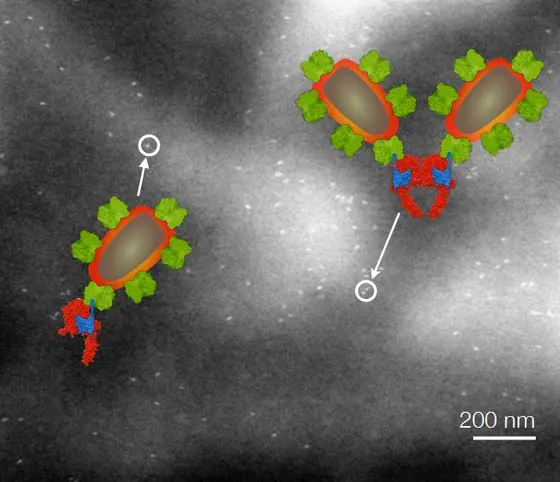For their studies researchers from the INM – Leibniz-Institute for New Materials, Saarbrücken and from the German Cancer Research Center (DKFZ) in Heidelberg used a new electron microscopy method called Liquid STEM. It allows nanoscale studies of intact cells in their native liquid environment.
The scientists have studied the local variations of HER2 membrane protein and of its dimers. HER2 is a member of the human epidermal growth factor receptor (EGFR) family. These family members trigger cell growth signals, when two of the membrane proteins are bound into a protein complex (dimerization). This happens usually after the binding of a small protein, the epidermal growth factor, which circulates in the blood stream and serves as communicator to transmit signals that regulate cell growth. HER2 is special in the sense that it does not need the growth factor protein in order to form dimers. It is thus capable of triggering cell growth without external regulation. In certain types of breast cancer, amplified levels of HER2 and its dimerization are known to drive unrestricted cell growth. HER2-tailored antibody-based therapeutics entered clinical practice more than a decade ago. These drugs aim to prevent cell growth triggered by HER2 homo- and/or heterodimerization.
“We found out, that HER2 dimers appeared to be absent from a small sub-population of resting SKBR3 cells. Could such cells survive the therapy and then develop into a drug resistant cancer at a later stage? It thus seems to be of key significance to study this sub-population of cells with exceptional phenotype," says Niels de Jonge, head of the Innovative Electron Microscopy group.
HER2 dimerization processes were thus far mostly studied on the basis of cell population averages, for example, with biochemical methods using pooled cell material, and information about the localization of HER2 dimerization was lacking. Therefore, the researchers around de Jonge pioneered the electron microscopy method Liquid STEM to imaging these receptors on cancer cells. The cells were examined on a microchip placed in the electron microscope, and remained intact and in liquid. “Specimens cannot be studied in liquid with traditional electron microscopy", explains Professor de Jonge. “Cells are typically studied in dry state via thin sectioning of solid dried plastic embedded or frozen material. The role of HER proteins is a “hot“ topic in cancer research but despite large research efforts using a wide range of techniques over the past decades this important information was not unveiled before. Our novel findings were obtained as a direct consequence of the high spatial resolution of Liquid STEM combined with its capability to study many intact cells in liquid," says de Jonge.
D. B. Peckys, U. Korf, N. de Jonge: Local variations of HER2 dimerization in breast cancer cells discovered by correlative fluorescence and liquid electron microscopy. Science Advances, 2015, DOI: 10.1126/sciadv.1500165



